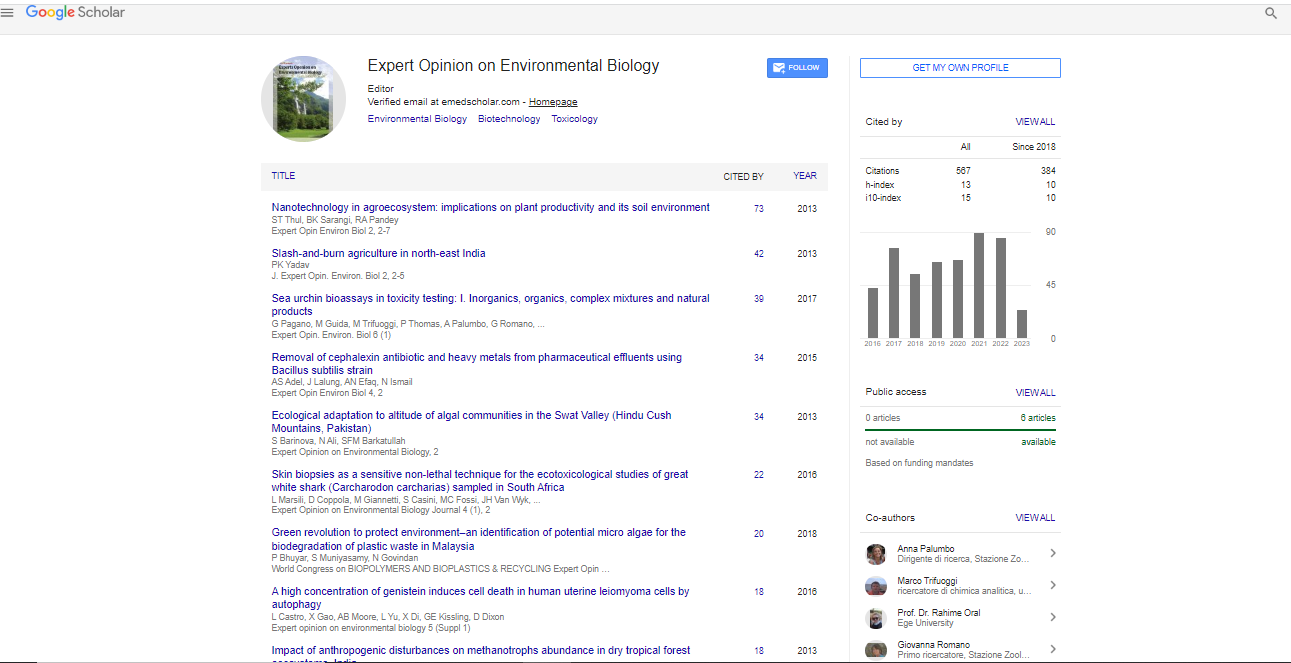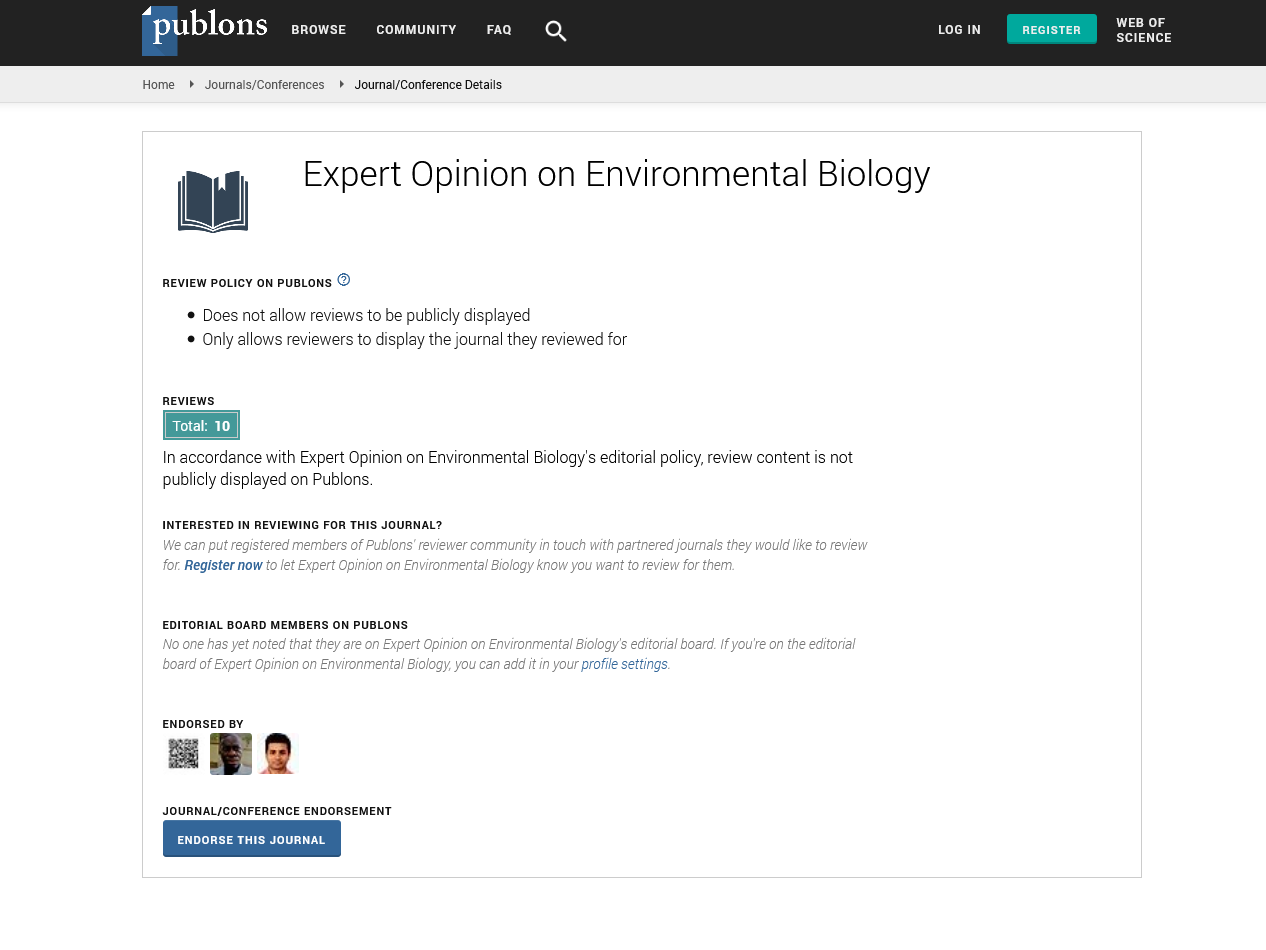Opinion Article, Expert Opin Environ Biol Vol: 13 Issue: 4
Enhancing the Strategies for Sustainable Ecosystem Management
Wuian Jing*
1Department of Environment and Ecology, Tsinghua University, Shenzhen, China
*Corresponding Author: Wuian Jing,
Department of Environment and Ecology,
Tsinghua University, Shenzhen, China
E-mail: wuianjing@tun11.cn
Received date: 27 November, 2024, Manuscript No. EOEB-24-154088;
Editor assigned date: 29 November, 2024, PreQC No. EOEB-24-154088 (PQ);
Reviewed date: 13 December, 2024, QC No EOEB-24-154088;
Revised date: 20 December, 2024, Manuscript No. EOEB-24-154088 (R);
Published date: 27 December, 2024, DOI: 10.4172/2325-9655.1000228.
Citation: Jing W (2024) Enhancing the Strategies for Sustainable Ecosystem Management. Expert Opin Environ Biol 13:4.
Description
Sustainable ecosystem management is essential to maintaining the health and functionality of natural systems that provide vital services for human society and the environment. Ecosystems, ranging from forests and wetlands to marine environments, support biodiversity, regulate climate, purify water and provide food and resources. However, human activities such as deforestation, pollution, overfishing and urbanization, are placing severe pressure on these systems. To safeguard the future of both ecosystems and humanity, the development and enhancement of sustainable ecosystem management strategies are imperative. Sustainable Ecosystem Management (SEM) involves managing natural resources in a way that meets current needs without compromising the ability of future generations to meet their own needs. It presents a detailed approach to managing land, water and living resources, ensuring that human development is in harmony with the environment.
SEM's primary objective is to preserve the sustainability of the environment while increasing resistance to threats like climate change, invasive species and resource depletion. Effective sustainable ecosystem management requires understanding the complex relationships within ecosystems and applying this knowledge to develop strategies that conserve biodiversity, optimize resource use and minimize negative impacts on the environment. One of the most important strategies for sustainable ecosystem management is Integrated Resource Management (IRM). IRM takes a complete approach, considering the interactions between ecosystems, the economy and human societies. This strategy shows the inter-linked nature of various ecological components and the need to manage them collectively rather than in isolation. By utilising ecological, social and economic considerations, IRM seeks to balance the needs of human populations with the protection and enhancement of natural systems.
For example, managing water resources for both agricultural and environmental purposes can ensure that rivers remain healthy while also supporting agricultural productivity. Biodiversity is the foundation of healthy ecosystems, as it contributes to ecosystem services such as food provision, water purification and soil fertility. Sustainable ecosystem management strategies prioritize the conservation of biodiversity by protecting vital habitats, reducing fragmentation and resisting threats like invasive species and overexploitation. Establishing protected areas, such as national parks, wildlife reserves and marine protected areas is a key element in preserving biodiversity. Additionally, biodiversity conservation can be supported through habitat restoration projects, which aim to repair ecosystems that have been degraded by human activities. Ecosystem restoration is the process of regenerating ecosystems that have been damaged or degraded.
Restoration strategies focus on repairing the functions of ecosystems, such as reintroducing native species, restoring hydrological cycles and re-establishing nutrient cycling. Restoration can help improve ecosystem health, increase biodiversity and enhance adaptability to climate change. In the case of forests, ecosystem restoration may involve reforestation or afforestation efforts to restore tree cover. For marine ecosystems, restoration activities might include coral reef restoration and efforts to reduce ocean pollution. Successful ecosystem restoration requires a thorough understanding of local ecosystems and active involvement from local communities and stakeholders. Sustainable agriculture and forestry practices are essential for the long-term health of ecosystems.
These practices aim to balance the need for food, timber and other resources with the conservation of ecosystem functions. Techniques such as agroforestry, crop rotation and organic farming reduce the environmental impact of agricultural practices and enhance soil health and biodiversity. In forestry, sustainable practices focus on selective logging, forest management plans and reducing the impact of deforestation. These methods can help preserve habitats, reduce soil erosion and maintain the carbon storage capabilities of forests. Climate change is one of the most significant challenges to ecosystems worldwide. Rising temperatures, changing precipitation patterns and more frequent extreme weather events are impacting ecosystems and biodiversity. Sustainable ecosystem management strategies must include both climate change reduction and adaptation measures.
Conclusion
Enhancing strategies for sustainable ecosystem management is important for the preservation of biodiversity, the functioning of ecological systems and the well-being of human societies. By increasing conservation, restoration, sustainable resource use and climate change reduction, one can ensure that ecosystems continue to provide vital services for generations to come. Effective governance, community involvement and global cooperation are key to overcoming the challenges facing ecosystem management. With continued efforts, it is possible to achieve a sustainable balance between human development and environmental preservation, safeguarding the planet’s ecosystems for future generations.
 Spanish
Spanish  Chinese
Chinese  Russian
Russian  German
German  French
French  Japanese
Japanese  Portuguese
Portuguese  Hindi
Hindi 
